ग्वार, बाजरे के 8 प्रमुख रोग एवं उनका प्रबंधन
Rajasthan is a major producer of Cluster beans (Cyamopsistetragonoloba L) or guar among Indian states. The State produces more than 70% of total guar seed produced in the country. Guar splits, churi and Korma. Guar split is used as a main products for different industrial uses while Churi and Korma are used as cattle feed.
Guar gum, also called guaran, is a galactomannan polysaccharide extracted from guar beans that has thickening and stabilizing properties useful in the food, feed and industrial applications. The guar seeds are mechanically dehusked, hydrated, milled and screened according to application.
Bajra is a hardy crop grows well, even in drought conditions, high temperatures and low soil fertility, which is probably why it has become an integral part of Rajasthani food.
Nutritional Values Per 100 Grams: Energy: 361 Kcal, Carbohydrates: 67 gms, Protein: 12 gms, Fat: 5 gms, Minerals 2 gm, Fibre: 1 gm, Calcium 42 gms, Phosphorus: 296 gms, Iron: 8 mg.
A. Major Disease of Guar and their management:-
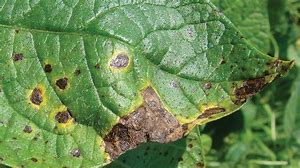 1. Bacterial blight :-
1. Bacterial blight :-
It is caused by a bacterium Xanthomonascyamopsidis.
Symptoms:
This disease infestation mostly occurs during kharif season crop at the surface of leaf. The spot of the disease are intraveinal, round and well defined on the dorsal surface of the leaf.
The pathogen invades vascular tissues and causes flaccidity of the affected portion. The flaccid spots become necrotic and turn brown. The infection advances to petiole and stem. It results in blackening and cracking of stem.
Management :
- Resistant varieties and certified seed should be used for sowing purpose ex. DurgapuraSafed, Durgajay, Agaita Guara-111,Agaita Guara-112, FS-277.
- Seed should be treated with 250 ppm of agrimycine or 200 ppm of streptocycline for 3 hours.
- Spray of streptocycline @ 5 g or plantomycine @ 50 g with 100 L water per hectare should be done at 35-40 days after sowing.
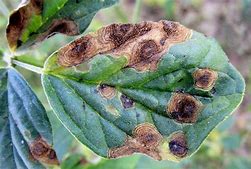 2. Alternaria leaf spot :-
2. Alternaria leaf spot :-
The casual organism of alternaria leaf spot disease is a fungus Alternariacyamopsidis.
Symptoms:-
The symptoms of the disease appear mainly on the leaf blade of leaves as dark brown, round to irregular spots varying from 2 to 10 millimeter in diameter.
The water soaked spots later on turn grayish to dark brown with light brown lines inside the spots.
Management :-
Spray of zineb @ 2 kg in 500 L of water per hectare should be done at an interval of 15 days at least twice.
3. Anthracnose :-This disease is caused by Colletotrichumcapsici f. cyamopsicola.
Symptoms:-
The symptoms of the disease appear on the leaves, petiole and stem in the shape of black spots.
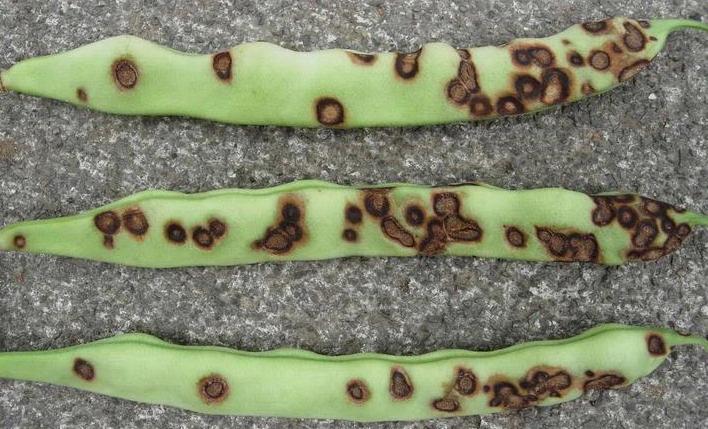
Management :-
Spray of zineb @ 2 kg in 500 L of water per hectare should be done for controlling this disease.
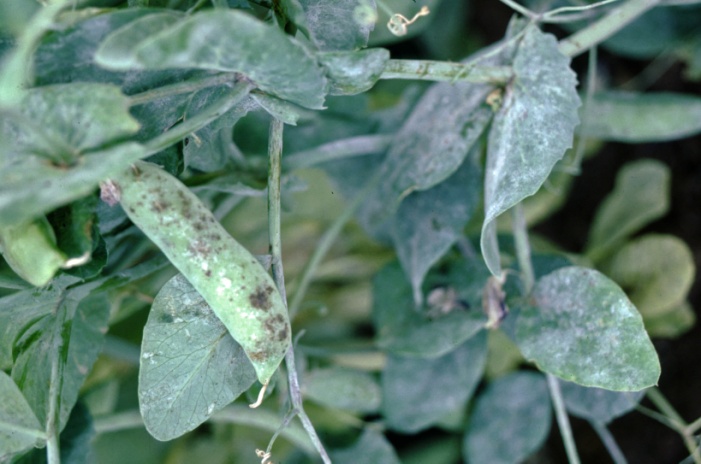 4. Powdery mildew :-This disease is caused by a fungus Erysiphepolygoni.
4. Powdery mildew :-This disease is caused by a fungus Erysiphepolygoni.
Symptoms:-
The symptoms of the disease start with white powdery growth over the leaf surface. This white growth consists of the fungus and its spores.
Disease Management :-
The disease can be controlled by spray of wettablesulphur like suffex at the rate of 2-3 kg ha-1 or dusting of sulphur powder @ 20-25 kg ha-1 or spray of dinocap @1.5 ml L-1 of water.
B. Bajra ( PennisetumGlaucum, Family: Poaceae)
5. Downy mildew :-This disease is caused by a fungusSclerosporagraminicola .
Symptoms :
The characteristic symptoms of Downy Mildew disease are pale, chlorotic, broad streaks extending from base to tip of leaves. At the advancement of disease, the leaf streaks turn brown and the leaves become shredded longitudinally. In severe infection, the downy fungal growth can be seen on the upper as well as lower surface of the leaves.
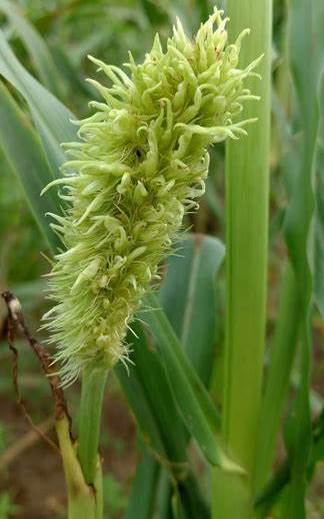 The rapid growth of fungal pathogen is favoured by rainy and humid environment. The infected plants fail to form ear but if formed, they are malformed to green leafy structures.
The rapid growth of fungal pathogen is favoured by rainy and humid environment. The infected plants fail to form ear but if formed, they are malformed to green leafy structures.
The complete ear can be transformed into leafy structure. The fungal pathogen transformed all floral parts such as glumes, palea, stamens and pistils into green linear leafy structures of variable lengths. As the disease advances, the malformed floral structures of ears become brown and dry.
Survival and spread :
The oospores remain viable for eight months to ten years or more in the soil, which makes primary infection in host plants and present abundantly in diseased leaves fall on the ground. The secondary spread of disease starts from sporangia, which are most active in moist environment.
Favorable conditions :-
The atmospheric temperatures between 15-25 °C and relative humidity above 85 per cent. Light drizzling accompanied by cool weather is highly favourable.
Management :-
Cultural options :-Sowing early season varieties-Giant Bajra, MPMH-17, FBC-16, TNSC-1.
Chemical control :-Fungicides applied specifically for downy mildew control may be unnecessary. Broad spectrum protectant fungicides such as chlorothalonil, mancozeb, and fixed copper are at least somewhat effective in protecting against downy mildew infection.
Organic control :-One way to control downy mildew is to eliminate moisture and humidity around the impacted plants. Watering from below, such as with a drip system, and improve air circulation through selective pruning. In enclosed environments, like in the house or in a greenhouse, reducing the disease.
6. Ergot :-This disease is caused by a fungus Clavisepsfusiformis.
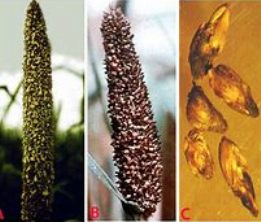 Symptoms :
Symptoms :
Sphacelial (conidial) "honeydew" sporulation has been reported on pearl millet (Frederickson and Mantle 1996). Cream to pink mucilaginous droplets of "honeydew" ooze out of infected florets on pearl millet panicles and form sclerotia.
Within 10 to 15 days, the droplets dry and harden, and dark brown to black sclerotia develop in place of seeds on the panicle. Sclerotia are larger than seed and irregularly shaped, and generally get mixed with the grain during threshing.
Survival and spread :-
The sclerotia take about 30-45 days to germinate and produce air borne spores which spread primary infection to pearl millet crop. The secondary spread of the disease is through conidia produced in large numbers in honey dew and disseminated by insects or rain.
Favourable conditions :-
Conditions favoring the disease are RH greater than 80% and 20 to 30oC temperatures.
Management :-
Crop rotation: Because ergot sclerotia usually do not survive longer than a year in the soil [1], Deep plowing buries sclerotia in the soil. Ascospores are not formed or they cannot be released into the free air in spring.Wild and weedy grasses and cereal volunteers should be controlled by herbicides to reduce primary inoculum.
Burning :- Post-harvest field burning is a proven measure to reduce inoculum from ergot and other diseases and pests [1] . Removing sclerotia from grain before milling is a standard procedure in large mills.
Seed separation:- Separate infested seed from normal seed by soaking in 10% salt solution. Floating light weight infested seeds are separated from normal grain which sinks to the bottom
Irrigation: Information on the effect of irrigation practices is scarce. Because ergot develops most successfully under humid conditions, an irrigation at the beginning of flowering might promote the onset of the disease [2].
Fungicides :- azoles, benomyl at 0.2% a.i., propiconazole and tebuconazole are most effective with low inoculum pressure, under dry conditions and when spraying occurs before the onset of disease (preventive).
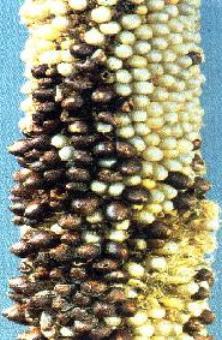 7. Smut :- This disease is caused by a fungus Tolyposporiumpenicillariae.
7. Smut :- This disease is caused by a fungus Tolyposporiumpenicillariae.
Symptoms :-
Immature, green sori larger than the seed develop on panicles during grain filling stage. A single sorus develops per floret. As grain matures, sori change in color from bright green to dark brown. Sori are filled with dark teliospores.
Survival and spread :-
The primary infection of the disease starts from air borne spores, which produce sporidia on germination that enter in the spikelets and infect ovary. Teliospores may remain viable in the soil and sporidia may be produced (Patel et al. 1959).
Favourable conditions :-
Optimum environmental conditions for maximum infection include: temperatures of between 25 and 35°C and slightly acidic soils favour the disease development.
Management :-
Use of resistant cultivars is the most economical and effective method for the control of smut disease. Seed treatment with organo mercurial fungicide viz., 2.5 gmAgrosan/Ceresan or 3 gm of Thiram/Captan per kg of seed to prevent the introduction of smut in to new areas.Remove diseased ears early in season and destroy them.
8. Rust :This disease is caused by a fungus Pucciniapenniseti.
Symptoms :
On pearl millet: small reddish-brown to reddish orange, round to elliptical uredinia develop mainly on foliage. As severity of infection increases, leaf tissue will wilt and become necrotic from the leaf apex to base. In infection sites developing late in the season, uredinia are replaced by telia which are black, elliptical, and sub epidermal.
 Survival and spread :
Survival and spread :
The uredospores survive for a short time in soil and infected debris. Presence of alternate host helps in perpetuation of the fungus.
Favourable conditions :
Low temperature of 10 to 12˚C favours teliospore germination. A spell of rainy weather favours the onset of the disease.
Management :-
Rust causing fungi develop on many grass weeds. These weeds help in spreading the disease to pearl millet crop. So, good weed control practice help reduce the rust disease in pearl millet.
Growing of rust resistant cultivars are advised in rust endemic areas.
Dusting of Sulphur and similar inorganic chemicals applied frequently enough do control rust but this may not be economical to the farmers growing pearl millet for grain.
Reference :-
1. Schumann G.L. Ergot. Plant Health Instr. 2000. [(accessed on 15 December 2014)]. (updated 2005
2. Alderman S. Ergot: Biology and Control. [(accessed on 30 September 2014)];2006.
Authors
1Poonam Kumari , 2Lokesh kumar ,
1Ph.D Scholar, Plant Pathology , Sri Karan Narendra Agriculture University, Jobner, Jaipur ( Raj.)
2Ph.D Scholar, Extention Education, Rajasthan College of Agriculture, MPUAT, university ,udaipur
1Email –
